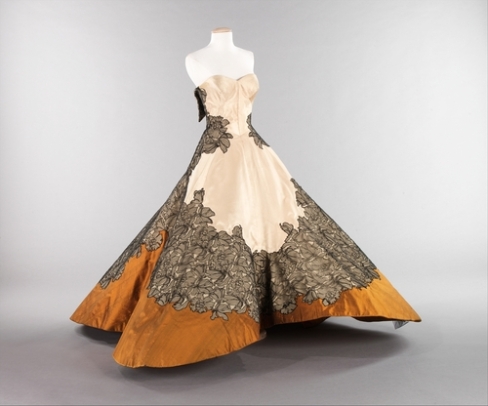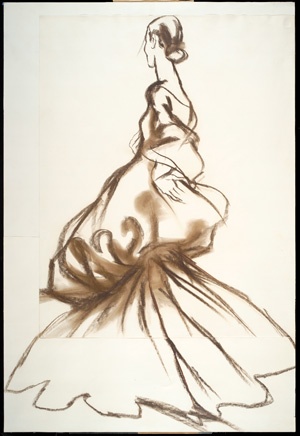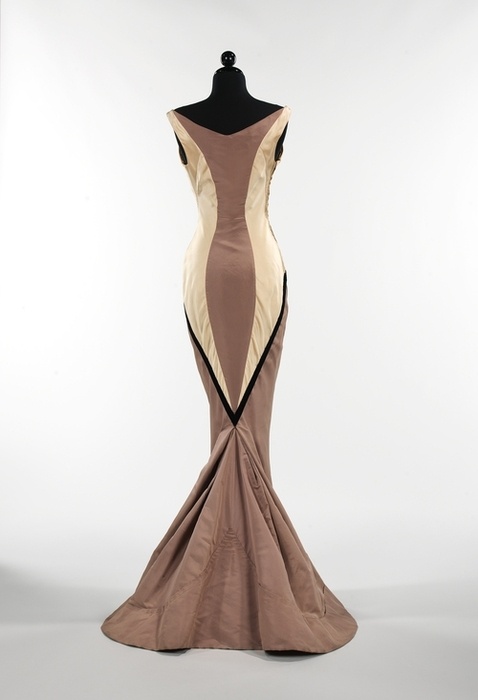Charles James - Photo Cecil Beaton, 1929
Biography
Often cited as the greatest American couturier, Charles James was actually born (1906) and raised in England , but began his career as a hatmaker supported by friends of his mother in Chicago, where he sculpted his creations directly on the heads of his clients. Before he was educated at Harrow, a British public school, where he met the fellow fashion enthusiast and fashion photographer Cecil Beaton, whose images later defined his work. Charles was described by a friend, Sir Francis Rose, as temperamental, artistic, and blessed even in childhood with the ability to escape the mundane chores of life-like a trapeze artist.
In 1928 Charles heads for Long Island with just 70 cents and an assortment of hats to his name, after he left Chicago in a swirl of financial confusion. He sets up a studio in a carriage house once rented by Noël Coward in Southampton. Socialite Diana Vreeland is a client; she will later recall Charles at the time running “up and down the Southampton Beach in beautiful robes showing his millinery on his head.
Charles James at work
Charles James and Mrs Randolph Hearst
His training as a milliner would shape his approach to clothing design. Much as a hatmaker uses a block, Charles viewed the female form as an armature on which to build his highly sculptural pieces. Never afraid to try new materials, spiraled a zipper around the torso in 1929, thus designing his famous taxi dress. To give strength and shape to the luxurious fabrics he favored, Charles often underpinned them with a framework of millinery wire and buckram for bombast. Though his dresses weighed up to eighteen pounds, his technical prowess ensured that the wearer moved as gracefully as a ballerina. Witness the garment that Charles considered his “thesis” in dressmaking: the Four Leaf Clover ball gown, which, viewed from the top, indeed resembled the lucky charm. To create the unique quatrefoil silhouette, James engineered a complex undercarriage of multiple petticoats, over which floated a skirt of cream duchesse-satin, its four structured “petals” emphasized by a wide undulating band of black velours de Lyon.
Four Leaf Clover ball gown
Because of various financial escapades that skirted the limits of legality, James found himself in 1939 no longer welcome in England. The next year he opened Charles James, Incorporated, at 64 East Fifty-seventh Street, New York City. Virtually ignoring wartime rationing, he began designing collections for Elizabeth Arden and redesigning her couture collection in 1944; their relationship was severed in 1945 because of financial problems .
His impressive acts of achievement in construction earned Charles a reputation as fashion’s premier architect, known for his sumptuous eveningwear as well as his ingeniously seamed coats. “Mathematical tailoring combined with the flow of drapery is his forte,” Vogue noted in 1944. Even the venerable Cristobal Balenciaga, himself a master of cut and cloth, was unsparing in his praise of Charles James, calling him “the world’s best and only dressmaker.” Christian Dior described his designs simply as “poetry.”
Charles James cloaks by Cecil Beaton for Vogue, 1936
In 1948, Cecil Beaton photographed one of Vogue’s most memorable images, eight models in the eighteenth-century drawing-room of French & Company, a Manhattan antiques dealer. Their hair chicly coiffed, necks craned like swans, the young beauties in the composition were swathed in sculpturesque ball gowns of silk and satin, taffeta and velvet. Together, they created a harmonious palette—icy blues and grays, punctuated by surprising combinations of celadon and lemon, rust-orange and petal-pink. Posed against the Louis Seize–wall-panels, each figure emerged as a singularly exquisite study in color and texture. Indeed, if not for Beaton’s masterful lighting—soft shadows trace the curve of collarbone and shoulder-blade, the drape and billow of skirts—the women themselves could have been the rare objets on display.
The designer of this lavish fashion tableau was Charles James, “master of color comparatives, of the cut and fold of exceptional cloths”, as Vogue wrote.
Cecil Beaton for Vogue. Dresses by Charles James
Between the late forties and mid-fifties—around the time the Beaton photo ran—Charles was at the height of his powers. He finally achieved success and recognition, won two Coty awards in 1950 and 1954 for “great mystery of color and artistry of draping”. His pieces were already sought after by collectors and museums, as well as by those wealthy patrons willing to pay his exorbitant fees—not to mention, gamble on the actual delivery of a commissioned design. “Charles James felt there was not enough money in the world to buy his garments,” one client bluntly remarked. His desire to receive out-sized financial rewards for his designs, coupled with perfectionism and his insistence on total control, eventually destroyed him.
Charles James was, in short, an egomaniac. He considering himself an artist rather than a dressmaker, and was so strongly attached to his creations that he felt they ultimately belonged to him. He would borrow back a dress from one client, only to lend it to another; or, worse, loan it out for an advertising campaign for feminine products. At minimum eccentricity, the darkly handsome designer—who was said to have been an excellent model for his own work—might don a finished gown and dance all night in his apartment above the Chelsea Hotel before handing it over . . . if he handed it over at all. he did not let go of his creations easily. He made his clients pay, sometimes twice for the same gown, and sometimes for a garment he had also promised another client. He was notorious for not having garments delivered on time.
Among his most ardent (and patient) devotees were Babe Paley, Mona von Bismarck, the Standard Oil heiress Millicent Rogers—who steadfastly supported him throughout his career—and, deliciously, the burlesque performer Gypsy Rose Lee, for whom he created elegant designs for her strip-tease. Fellow couturiers Elsa Schiaparelli (who had to pay) and Coco Chanel (who didn’t) also put in orders.
Antonio Lopez illustrations of Charles James's designs
A perfectionist to the extreme, Charles James was capable of spending thousands of dollars developing the ideal sleeve or a staggering twelve years on a single frock. He would “far rather work and rework a beautiful dress ordered for a certain party than have that dress appear at that party,” Diana Vreeland once observed. Such obsessive tendencies, combined with his taking investors on a wildly careening roller-coaster ride in his business dealings—in short, promising unicorns and rainbows and delivering absolutely zip—would ultimately prevent the designer from achieving the kind of success his genius deserved.
By 1958 Charles was a beaten man, unwelcome on Seventh Avenue, and mentally, physically, and financially drained. In 1964 he moved into New York’s bohemian hotel, the Chelsea. Here he worked with the illustrator Antonio Lopez to document his career. Old clients joined with his protégé Halston in 1969 in a bravely attempted salute to his career. Charles attempted to document the creations of a lifetime, whether they were in public or private holdings. Above all, during those final years of his life, Charles James was fanatical about securing his proper place in the history of twentieth-century fashion.
He dies in 1978 of pneumonia in the Chelsea Hotel, alone and penniless.
Charles James at work
.
.
Exhibition in the Metropolitan

Charles James: Beyond Fashion
The inaugural exhibition of the newly renovated Costume Institute will examine the career of the legendary twentieth-century Anglo-American couturier Charles James (1906–1978). Charles James: Beyond Fashion will explore James’s design process, focusing on his use of sculptural, scientific, and mathematical approaches to construct revolutionary ball gowns and innovative tailoring that continue to influence designers today. Approximately one hundred of James’s most notable designs will be presented in two locations—The New Costume Institute as well as special exhibition galleries on the Museum’s first floor.
Petal evening dress


La Sirene Evening Dress
La Sirene Evening Dress, 1938
Butterfly gown
Tree gown
Swan gown
Diamand gown
.
information found on: website of the Metropolitan Museum of Art
http://www.vogue.com/voguepedia/Charles_James




































Bottom photo of Charles James and Roberto Polo at the Hotel Chelsea 1975 is by Greg Kitchen
Of course he was an egomaniac. He wouldnt compromise and why should he, the body of work he has left behind is extraordinary. A single one of these dresses would be the highlight of many other designer’s careers. He simply was not interested in the acquiring of wealth his concern was the creation of work that remains to this day, totally sublime.
Reblogged this on Corporeal Editorial and commented:
Charles James
Charles James was vulnerable enough to allow his artistry his fullest scope. He allowed himself no compromise, and gave his all to every commission he took on. His eye for shape and color and the living flow of the garment’s design was simply unparalleled. This man was a brilliant and difficult perfectionist of his craft. No one else has even come close, excepting the Kabuki designers of olden times. I would love to see his hats. Bravo, Maestro James. I hope that God has placed you in charge of designing the angel’s gowns. You would be so deserving of it.
Who wrote this article?
????